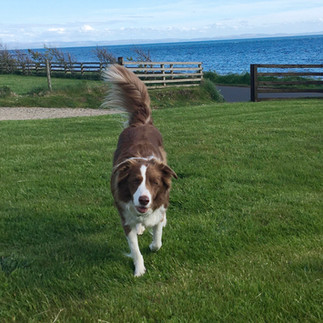Come Back! Teaching Your Dog to Come When Called
- Clare Russell

- May 2
- 3 min read
Tips for improving your recall
We failed to realise that the kind of ‘recall’ needed for a walk in the park differed from the classroom version.
Having worked with hundreds of dogs, I find it difficult to write "recall" without using quotation marks, and here's the reason why.
Training Class Recall
My first experience of recall training was as an owner of a new pup. I went to puppy training classes and, like most at that time, the class had its roots in the obedience competition world.
The 'recall' exercise looked something like this – the class assistant would hold the dog, we walked away, we turned to stand facing our dogs and then called our dogs to us with lots of excitement and dog received a treat. We built on this by asking the dog to sit in front of us before receiving their piece of food.

When I started teaching classes, I conducted the same training, but individuals consistently mentioned that this training didn’t apply in the park. After considering it carefully, I figured out the reason:
The dogs were being restrained by a stranger - depending on their personality, they either loved it or were in a state of panic as we walked away. When we turned around the dogs who enjoyed the attention of a novel person were busy jumping over person and unlikely to be taking any notice of our cues. The pups who were experiencing abandonment, were too stressed to take in any of the information and were simply fleeing back to the safety of their owner.
We weren’t clear about what we were teaching. We thought we were teaching one single behaviour called ‘recall’. Instead we were teaching a dog to come to our open hands when we were facing them. This is undoubtedly a valuable behavior to teach, and I urge all dog owners to train their dogs in this, recognising that it is just one component of the overall 'recall' strategy.
We didn’t understand that the type of ‘recall’ required for a walk in the park was different from the classroom version.
We overlooked the fact that our dogs were following their instincts in the park, instead of learning in a classroom setting.
Instinctively our dogs already know how to:
Stay connected with their group
Return to, or find, a safe place following a frightening event.
Work together co-operatively to hunt, play and find safety.
These are natural life skills in our dogs. What we can teach them is that we can be present for all these activities, serving as a safe haven, a fantastic hunting partner (for food and toys!), and that looking to us for information and staying connected is beneficial.

Recall has two parts:
Give up something, or stop doing that activity
Re-connect, run to me and stop in front
In class, the reward was focused on the second part, such as running to me and stopping in front, while the first part, "stop doing that," is challenging, particularly for a young dog or a dog with a hunting background.
By splitting our rewards between the two behaviors and prioritising the first, recall and connection are enhanced.
By asking the dog to 'sit' before rewarding, we unintentionally rewarded the sitting behavior rather than the 'recall'.
In the park, our priority is ensuring our dogs' safety and preventing our dog from bothering other people and their dogs. This isn't related to sitting. Concentrating on making our dog sit in front distracted us from rewarding the important behaviors.
We weren’t prepared for adolescence. For very young pups and anxious dogs safety is a primary reward, they naturally stay close to the group, whereas the hormones of adolescence awaken a dog to other delights. The desire of a dog to stay close to you for safety can no longer be relied upon. This is the time that a young dog may have to go back onto a long line, be walked with different dogs or exercised in a secure field.
We didn’t understand how much could be achieved at home or on lead. Neither distance or free running is essential to building positive 'recall' associations. A 6ft (2m) training lead can get you started. Noticing when your dog stops an activity to follow or watch you, can be rewarded. Words, cues and actions can be added as your dog moves with you around the house and garden.
Need more help?
A 1:1 Session is the premium experience, expert feedback and effective strategies to help you resolve your dog's behaviour problem https://www.clareteachingdogs.com/work-with-me












Comments